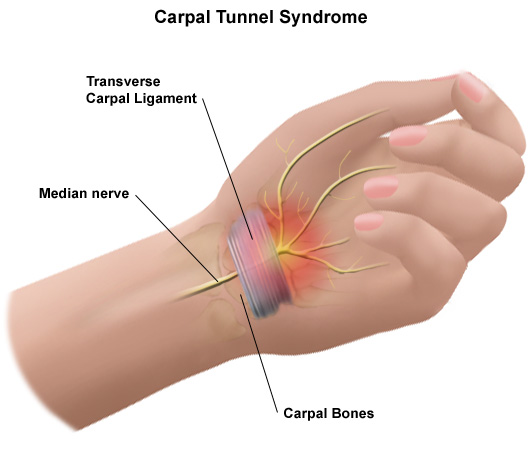Carpal tunnel syndrome is becoming a common condition nowadays and people are starting to become aware of it. It is a progressive condition which can cause extreme pain. Carpal tunnel syndrome is happens when a major nerve in the wrist gets compressed. This nerve is the median nerve, running from the fore arm all the way to the hand and manages sensations or feelings of the fingers. The median nerve is housed inside the carpal tunnel, which is a quite narrow passageway at the base of the hand, composed of ligaments and bones. The median nerve can be compressed or squeezed inside the carpal tunnel by various factors, the most common of which is the swelling and thickening of irritated tendons in the wrist. When this nerve is pressed, it causes pain or numbness in the hand and wrist, which can also reach the arms.
Causes of Carpal Tunnel Syndrome
There are many possible causes of carpal tunnel syndrome, some of which are still unknown. However, in most cases, carpal tunnel syndrome is normally caused by multiple reasons which collectively increase the pressure and affect the tendons and median nerve in the carpal tunnel.
The most common cause of the condition is congenital predisposition, meaning some people are just born with little carpal tunnels, making even minor swelling cause compression on the median nerve. Other factors which could contribute to the condition are injuries which cause swelling like sprain or fracture, mechanical problems in the wrist joint, and work stress.
Other medical conditions can also cause carpal tunnel syndrome, such as hypothyroidism and rheumatoid arthritis. Sometimes, over activity also contribute to the condition, such as overexertion of the pituitary gland or repeated use of vibrating hand tools.
However, the notion that repetitive hand and wrist motions due to work or leisure activities cause the condition is more of a misconception than a medical truth. These activities are more likely to cause motion disorders, and not carpal tunnel syndrome.
Symptoms of Carpal Tunnel Syndrome
Carpal tunnel syndrome is manifested by symptoms such as frequent tingling, burning, or numbness in the palm and the fingers, swelling, and failure to move or flex the hands and wrists. These symptoms often start gradually and people may easily dismiss them as a common cramp or as simply a sign of exhaustion. However, one should be on the lookout, especially when the symptoms worsen, as when he wakes up at night feeling the need to shake out the hand or wrist, or when he already feels reduced grip strength which makes it difficult for him to make a fist or grasp small objects. In such cases, there is a great probability that the condition is not merely a common cramp, but already carpal tunnel syndrome.
Carpal Tunnel Syndrome and Chiropractic Care
To reduce the severity of carpal tunnel syndrome and prevent it from ever coming back, a few visits to the chiropractor can help. Through a simple nerve adjustment in the hand, wrist, and arm, the pain should diminish and restore the motion of your hands, enabling you to go back to your usual daily routine.
